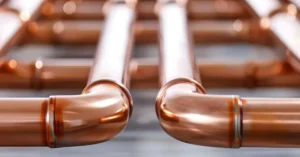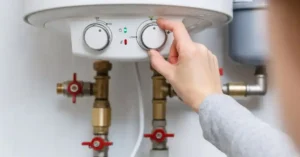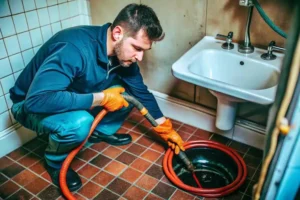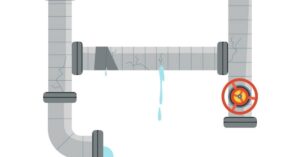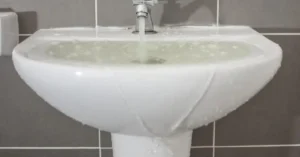
A blocked drain can be very inconvenient, and when the water doesn’t go down, many people reach for a shortcut: chemical drain cleaner. These strong liquids/gels promise speedy results, but they are also strong chemicals. This invites a simple and important question: how much pH does drain cleaner have? The answer is either very high or very low (alkaline or acidic). Typically they are highly reactive at either end of the pH scale. The pH of drain cleaner is important to know in order to safely use them and to understand how they work.
What Is The pH Of A Drain Cleaner?
The pH of drain cleaner refers to a range and not a singular number, since there are primarily two types of chemical drain cleaners. The pH scale representative numbers range from 0-14, with 7 representing neutrality, like pure water, the lower the number, the more acidic it is, while other numbers higher than 7 represent basic or alkaline. The closer its number is to 0 or 14, the more powerful is the chemical.
Most household drain cleaner pH levels are quite high, anywhere from an 11 to a 14, those are alkaline, or basic cleaners. A small number of them are highly acidic with a pH level between 0-2. These drain cleaners reflect a very strong chemical, in order to break down stubborn clogs.
Curious About the pH Value of Drain Cleaners?
The chemical strength is what makes the drain cleaner effective. The most frequently used alkaline cleaners contain sodium hydroxide, also known as lye, or potassium hydroxide. These products are considered highly alkaline. A lye-based cleaner is usually stated to have a pH of 13 or 14. This is the maximum number on the scale, indicating that they are very caustic. Drain cleaners that have a high pH value are exceptionally effective at dissolving hair and grease.Like alkaline cleaners, acid drain cleaners are less frequently used in a home setting and are primarily used in professional drain cleaning.
Other household drain cleaners, they also utilize strong acids, such as sulfuric acid or hydrochloric acid, for their active ingredient. The pH of acidic drain cleaners can be 0 or 1. The strong acidity of the chemical make it highly effective at dissolving materials, such as paper and organic matter. Both very low pH and very high pH chemical make the material very corrosive.
Why Does the pH of Drain Cleaner Matter?
The pH level is not just a scientific number; it tells you about three very important things: power, safety, and compatibility with your pipes.
1. Strength and Effectiveness
The extreme ph for drain cleaner directly relates to how well it works. A neutral substance, like water, will not break down a clog. A strong acid or a strong base, however, will break down the organic materials that cause clogs.
- High pH (Basic): Best for clogs made of grease, fat, and hair. The alkalinity melts these fatty deposits away.
- Low pH (Acidic): Best for more complex clogs that include paper, cotton, or heavy organic sludge.
This depth of understanding ensures you are not wasting time with a product that won’t work on your specific clog.
2. Safety and Chemical Hazard
The most important reason to know the pH is safety. Chemicals at the far ends of the pH scale are highly corrosive.
- A high pH substance is caustic, meaning it can burn and destroy living tissue, like your skin and eyes, on contact.
- A low pH substance is corrosive and can cause severe chemical burns and blindness.
The pH of cleaning products can be quite different from one another, with even a one-point difference on the pH scale equating to a ten-fold difference in power. For example, pH 13 is 10 times as powerful as a pH of 12. Knowing about the logarithmic scale is part of E-E-A-T – Experience, Expertise, Authority, and Trust – that demonstrates genuine expertise in a cleaning product.
3. Impact on Plumbing Materials
The pH level also determines which types of pipes a cleaner might damage.
- Alkaline cleaners are generally safe for most metal pipes and PVC. However, the heat produced by the chemical reaction can sometimes soften or warp older PVC or rubber seals. They are also known to react badly with aluminum, which is why you should never use them in a garbage disposal.
- Acidic cleaners can be extremely hard on older metal pipes, especially cast iron, and certain types of plumbing. Using the wrong cleaner can lead to expensive leaks and pipe replacements. This is why professional plumbers often warn against overusing chemical drain cleanings.
Drain Cleaner: Acidic or Base?
Drain cleaners fall into both categories: acidic and basic. Knowing which type you have is vital for safe use.
- Basic (Alkaline) Drain Cleaners: These are the most common type of drain cleaner. They often come in liquid or gel form and contain strong bases like sodium hydroxide or potassium hydroxide. These powerful bases work by creating a chemical reaction called saponification, which turns grease and fat into soap. This helps the clog wash away. They also dissolve hair and protein clogs. They are highly corrosive. This kind of drain cleaner on pH scale sits at the top end.
- Acidic Drain Cleaners: These contain highly concentrated acids. They work through a different chemical process called hydrolysis. They break down organic materials, like hair, paper, and food, by absorbing the water within them. Acidic cleaners are very effective, but they release strong fumes and are incredibly dangerous to handle. They are often used by professionals when alkaline cleaners fail.
Both extremes of the pH scale are dangerous. It is never a case of “acid is safer” or “base is safer.” Both pose serious risks to skin, eyes, and your plumbing if used incorrectly.
pH Indicator in Drain Cleaners
You won’t find a little pH strip attached to the bottle, but the main ingredients act as the indicator. Knowing the ingredient tells you the drain cleaner ph level.
| Common Ingredient | pH Range (When Concentrated) | Type | What It’s Best For |
| Sodium Hydroxide (Lye) | 12.5 – 14 | Basic (Alkaline) | Hair, grease, soap scum |
| Sulfuric Acid | 0 – 2 | Acidic | Paper, organic sludge, heavy clogs |
| Sodium Hypochlorite (Bleach) | 11 – 13 | Basic (Alkaline) | Oxidizing clogs, often mixed with lye |
Export to Sheets
This table shows a clear picture of the power you are dealing with. A quick look at the ingredient list on a bottle of ph value drain cleaner is your true indicator.
How to Use Drain Cleaner Safely
Since the pH level is so extreme, safety is non-negotiable. Using these products safely shows real experience and expertise. Never mix different drain cleaners or follow up a chemical cleaner with a different kind, as the resulting reaction can create toxic gases or violent splashing.
- Wear Protection: Always use rubber gloves that are thick enough for chemicals, and wear safety goggles. Regular eyeglasses are not enough. The fumes alone can irritate the eyes and lungs.
- Ensure Ventilation: Open a window or turn on a fan. You must have fresh air circulating to avoid inhaling toxic fumes, especially when dealing with acidic drain cleaner.
- Read the Label: Follow the manufacturer’s directions exactly. Pay attention to how long the product should sit in the drain and how much water to use for flushing. Never leave the product in the drain longer than the directions state.
- Use Cold Water: For most common drain cleaners, especially those based on lye, you should use cold water to flush the drain after the chemical reaction is complete. Using hot water can speed up the reaction too much, leading to dangerous back-splashing.
- Storage: Store the cleaner in its original, childproof container in a cool, dark, and secure location away from pets and children.
You can read about: $49 Drain Cleaning: The Real Cost of a Clogged Drain
When to Avoid Chemical Drain Cleaners
While knowing how much ph does drain cleaner have is helpful, it is also important to know when not to use it. Chemical cleaners are often a short-term fix.
-
Total Blockages: If the drain is fully blocked, the chemical will just sit in the pipe without working, leading to pipe damage or dangerous splash-back.
-
Toilets: Never use chemical drain cleaner in a toilet. The concentration of the chemical in the toilet bowl poses a major risk for splashing and fume inhalation. Use a plunger or a closet auger instead.
-
Recurring Clogs: If the clogs keep coming back, the issue is not surface-level. It points to a deeper plumbing problem, like tree roots or a broken pipe. Repeated use of chemical cleaners will just damage your pipes over time.
Choose Professional Drain Cleaning for Safe Solutions
For severe clogs, persistent issues, or to bypass the hazardous pH of store-bought alternatives, professional drain cleaning is your most effective method. Not only do experts in drain cleaning for example, Derks Plumbing have the tools (such as drain snakes or hydro-jetting), but they also have the experience to grapple with a complete clog and eliminate it, instead of causing damage with high pH or low pH chemical cleaning alternatives that could harm either your plumbing or the environment in your home.
When hiring service professionals, an organization such as Drain Cleaning Eagle Rock has a sustainable and long-term solution since their plumbers are expertly trained to uncover the complete collections issues cause clogs; they do not just treat the symptoms. This expertise provides an excellent value proposition, with the experts adhering to E-E-A-T best practices, especially if you have concerns about strong drain cleaning procedure pH or cleaning agents.
Conclusion
Comprehending the pH levels of drain cleaners can help make safe and responsible decisions for home repair. Most drain cleaners are highly basic with a pH that ranges from 12 – 14 while some are very acidic, having a pH rose to 0. Both types of drain cleaners are very caustic because of the high level of pH there use. They are very caustic at both ends of the pH spectrum.
All precautions of using chemical will need to be taken such as protective gear, proper ventilation, and in the case of blocked drains, you might want to have the work done by a professional. Do not hesitate to contact us with Derks Plumbing if you are in need of drain cleaning to make sure that your home will stay safe and your plumbing will be in great condition.
FAQ's
Is a drain cleaner with a pH of 13 dangerous?
Yes, absolutely. A drain cleaner with a pH of 13 is highly alkaline (basic) and extremely caustic. It can cause severe chemical burns to skin and eyes and release strong fumes. Always wear protective gear and ensure good ventilation when using any cleaner with such an extreme pH value.
Which is more effective: a high pH or a low pH drain cleaner?
It depends on the clog. A high pH (alkaline) drain cleaner is better at dissolving grease, hair, and soap scum, as its caustic nature turns fats into soap. A low pH (acidic) drain cleaner is often more effective at breaking down complex organic matter like paper and heavy sludge. For most common household clogs, a high pH cleaner is typically used.
Can I mix an acidic drain cleaner with a basic drain cleaner?
No, never mix different types of drain cleaners. Combining an acidic cleaner with an alkaline (basic) cleaner can cause a violent chemical reaction. This reaction can create a huge amount of heat, potentially damaging your pipes, or it can release toxic, explosive gases, making the situation very dangerous.
Is baking soda and vinegar a safer alternative to chemical drain cleaner?
Yes, a mixture of baking soda (mildly alkaline, pH 8-9) and vinegar (mildly acidic, pH 2-3) is much safer than high pH commercial drain cleaners. The reaction creates a fizzing action from carbon dioxide gas. This mixture is not powerful enough for heavy clogs, but it is a good, safe option for light maintenance and odor control.


